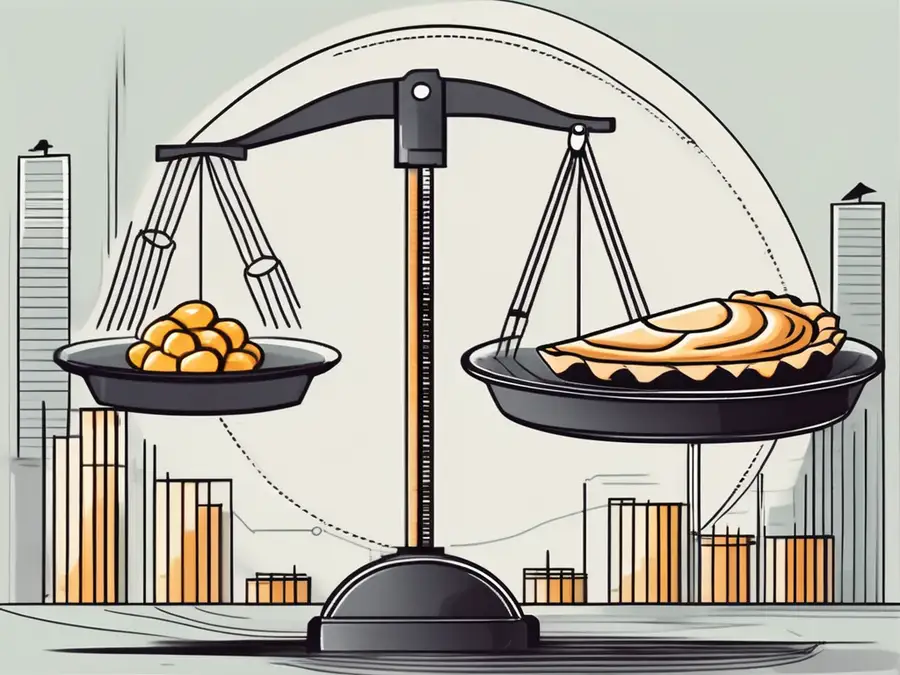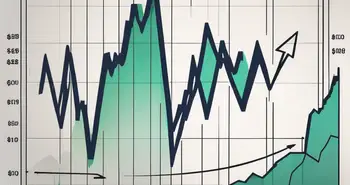The Ultimate Guide to Understanding Price to Earnings Ratio

As an experienced investor, I understand the importance of analyzing financial ratios to make informed investment decisions. One ratio that plays a crucial role in evaluating a company's financial health is the Price to Earnings (P/E) Ratio. In this guide, I will provide you with a comprehensive understanding of the P/E ratio and its significance in the world of investing.
Defining Price to Earnings Ratio
Let's start with the basics. The Price to Earnings (P/E) ratio is a valuation metric used to assess a company's stock price relative to its earnings per share (EPS). It is calculated by dividing the current market price of a company's stock by its earnings per share.
The P/E ratio is a widely used tool in the financial world, providing investors with valuable insights into a company's financial health and market perception. By analyzing this ratio, investors can make informed decisions about whether to buy, sell, or hold a particular stock.
The Basic Concept of Price to Earnings Ratio
At its core, the P/E ratio provides investors with insights into how much they are willing to pay for each dollar of earnings generated by a company. A higher P/E ratio suggests that investors are willing to pay a premium for future growth prospects, while a lower P/E ratio may indicate undervaluation.
For example, if a company has a P/E ratio of 20, it means that investors are willing to pay $20 for every $1 of earnings generated by the company. This indicates that investors have high expectations for the company's future earnings growth and are willing to pay a higher price for its stock.
On the other hand, if a company has a P/E ratio of 10, it means that investors are only willing to pay $10 for every $1 of earnings. This could suggest that the company is undervalued, as investors are not willing to pay a premium for its future growth prospects.
Importance of Price to Earnings Ratio in Investment
Understanding the P/E ratio is vital in evaluating investment opportunities. It helps investors identify potential bargains or overvalued stocks in the market. By comparing a company's P/E ratio to its peers or industry average, investors can gauge whether the stock is trading at a premium or a discount.
Moreover, the P/E ratio can also be used to assess the overall market sentiment towards a particular stock. If a company has a high P/E ratio compared to its peers, it may indicate that investors have high expectations for its future growth and are willing to pay a premium for its stock. Conversely, a low P/E ratio relative to its peers may suggest that investors have lower expectations or concerns about the company's future prospects.
It is important to note that the P/E ratio should not be used as the sole determinant for making investment decisions. Other factors such as the company's financial health, industry trends, and competitive landscape should also be taken into consideration. However, the P/E ratio serves as a valuable starting point for investors to assess a company's valuation and potential investment opportunities.
Components of Price to Earnings Ratio
Let's delve deeper into the components that make up the P/E ratio.
Understanding the ‘Price' in Price to Earnings Ratio
The ‘Price' in the P/E ratio refers to the market price of a company's stock. It represents the value that market participants are willing to pay for a share of the company's ownership.
When determining the price of a stock, various factors come into play. These factors include the company's financial performance, market demand, investor sentiment, and overall market conditions. Market participants analyze these factors to assess the fair value of a company's stock.
Investors often compare the current market price of a stock to its intrinsic value to determine whether it is overvalued or undervalued. Intrinsic value is an estimate of the true worth of a company's stock based on its fundamental factors, such as earnings, growth potential, and industry trends.
It's important to note that the market price of a stock can fluctuate daily due to market forces, such as supply and demand dynamics, economic news, geopolitical events, and investor sentiment. These fluctuations can impact the P/E ratio and influence investors' perception of a company's stock.
Deciphering the ‘Earnings' in Price to Earnings Ratio
The ‘Earnings' in the P/E ratio refers to the company's earnings per share (EPS). The EPS is calculated by dividing the company's net income by the number of outstanding shares. A higher EPS indicates that the company is generating more profit per share.
Earnings are a crucial metric for investors as they provide insights into a company's profitability and financial health. Positive earnings indicate that a company is generating profits, while negative earnings suggest losses. Investors typically prefer companies with consistent and growing earnings as it reflects their ability to generate returns on investment.
When evaluating a company's earnings, investors also consider factors such as revenue growth, profit margins, and operating efficiency. These factors help assess the sustainability and quality of a company's earnings.
It's important to note that earnings can be influenced by various factors, including industry trends, competition, economic conditions, and management decisions. Investors analyze these factors to understand the drivers behind a company's earnings and to make informed investment decisions.
Furthermore, earnings can be reported on a quarterly or annual basis. Quarterly earnings reports provide investors with timely updates on a company's financial performance, while annual earnings reports offer a comprehensive overview of its profitability for the entire fiscal year.
Investors also compare a company's earnings to its peers and industry benchmarks to assess its relative performance. This analysis helps investors identify companies that are outperforming or underperforming their competitors.
Calculation of Price to Earnings Ratio
Knowing how to calculate the P/E ratio is essential in leveraging this ratio for investment analysis.
Step-by-Step Process of Calculating P/E Ratio
To calculate the P/E ratio, you divide the market price per share by the earnings per share. For example, if a company's stock is trading at $50 per share, and its EPS is $5, the P/E ratio would be 10x ($50 / $5).
Common Mistakes in P/E Ratio Calculation
While the calculation of the P/E ratio is relatively straightforward, it's crucial to be mindful of potential pitfalls. One common mistake is using an outdated EPS figure or failing to exclude extraordinary one-time gains or losses from the earnings calculation. These errors can distort the true valuation of a company.
Interpreting Price to Earnings Ratio
Now that you know how to calculate the P/E ratio, let's explore how to interpret it.
What a High P/E Ratio Indicates
A high P/E ratio suggests that investors have high expectations for the future growth of the company. It may indicate that the stock is overvalued, as investors are paying a premium for the potential future earnings.
What a Low P/E Ratio Indicates
A low P/E ratio could indicate that the stock is undervalued, potentially presenting a buying opportunity. However, it's essential to conduct further analysis to determine whether the low P/E ratio is justified or if there are underlying issues affecting the company's earnings potential.
Price to Earnings Ratio in Different Industries
Now, let's examine how the P/E ratio can vary across different industries.
Role of P/E Ratio in Tech Industry
The technology industry is known for its high-growth potential, and it often commands higher P/E ratios compared to other sectors. This is because investors expect significant future earnings growth from tech companies as they innovate and expand their market presence.
Significance of P/E Ratio in Retail Industry
In contrast, the retail industry tends to have lower P/E ratios. This is partly due to the nature of the industry, which is characterized by intense competition and relatively lower growth rates. Investors in the retail sector generally value stability and predictability over rapid growth.
Throughout my investment journey, I have found the P/E ratio to be a valuable tool for assessing potential investments. By understanding its concepts, calculating it accurately, and interpreting it within the context of different industries, you can make more informed investment decisions. Remember, the P/E ratio is just one of many factors to consider, and it should always be used in combination with comprehensive fundamental analysis.
Now that you're equipped with the knowledge of the Price to Earnings Ratio and its pivotal role in making informed investment decisions, it's time to put that understanding into action. With Morpher, you can leverage the power of blockchain technology to trade across a multitude of asset classes without the burden of fees. Whether you're looking to invest in stocks, cryptocurrencies, or even niche markets like NFTs, Morpher's platform offers the flexibility of fractional investing, the advantage of short selling, and the security of a non-custodial wallet. Amplify your trades with up to 10x leverage and experience a unique trading environment. Ready to transform your investing journey? Sign Up and Get Your Free Sign Up Bonus at Morpher.com and join the future of trading today.

Disclaimer: All investments involve risk, and the past performance of a security, industry, sector, market, financial product, trading strategy, or individual’s trading does not guarantee future results or returns. Investors are fully responsible for any investment decisions they make. Such decisions should be based solely on an evaluation of their financial circumstances, investment objectives, risk tolerance, and liquidity needs. This post does not constitute investment advice.

Painless trading for everyone
Hundreds of markets all in one place - Apple, Bitcoin, Gold, Watches, NFTs, Sneakers and so much more.

Painless trading for everyone
Hundreds of markets all in one place - Apple, Bitcoin, Gold, Watches, NFTs, Sneakers and so much more.









